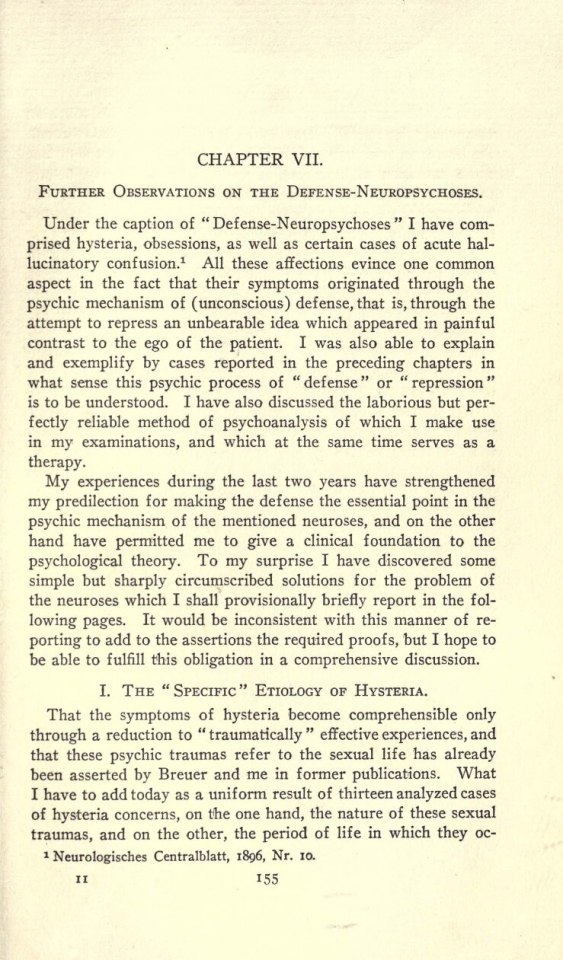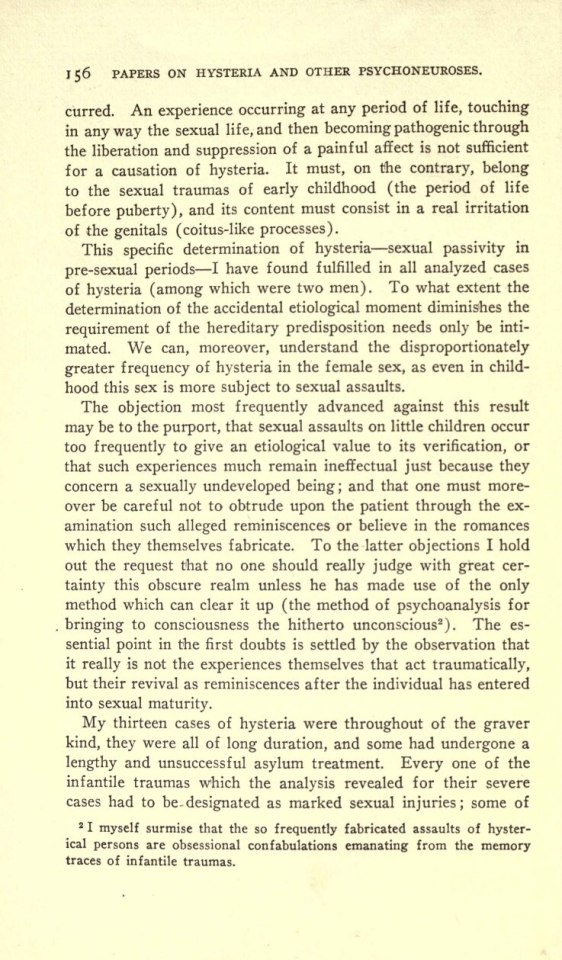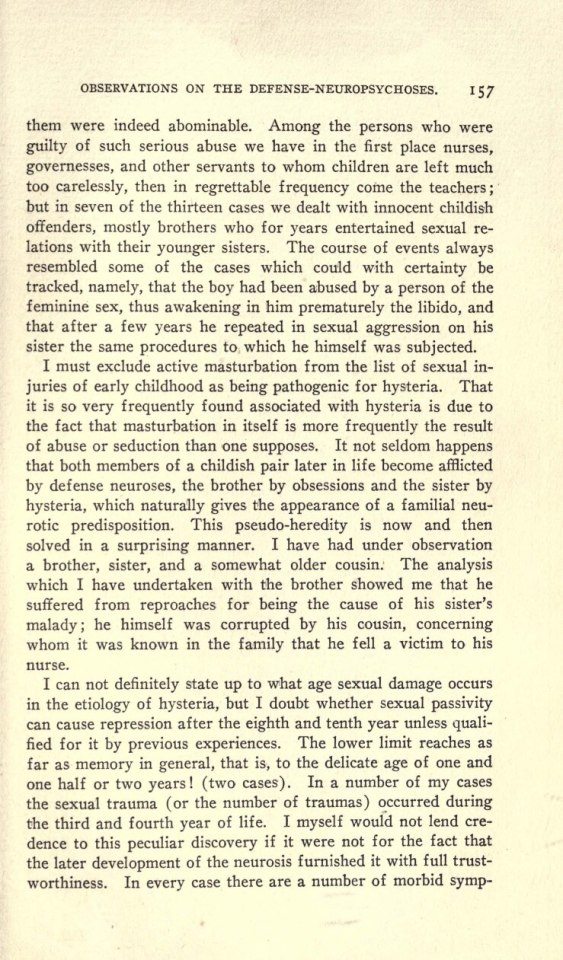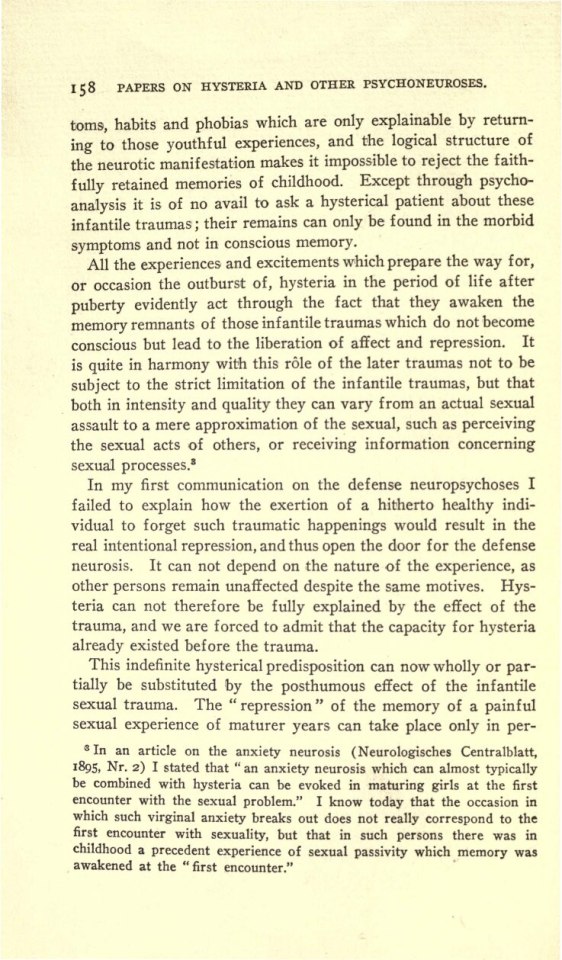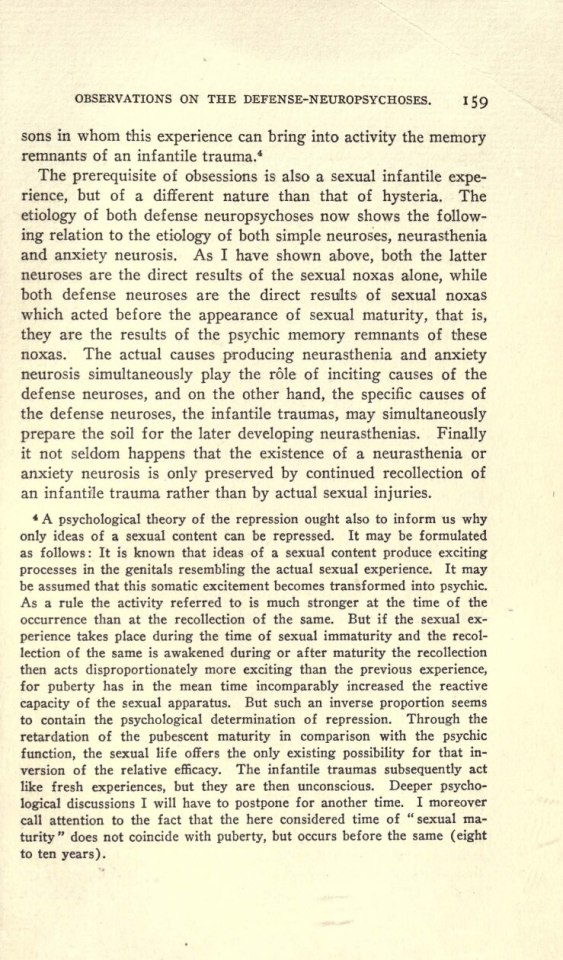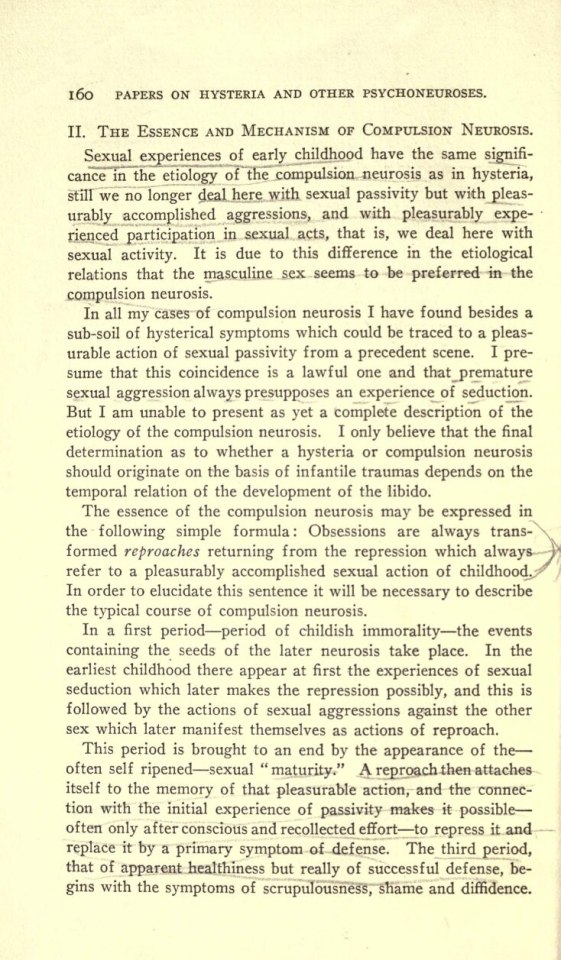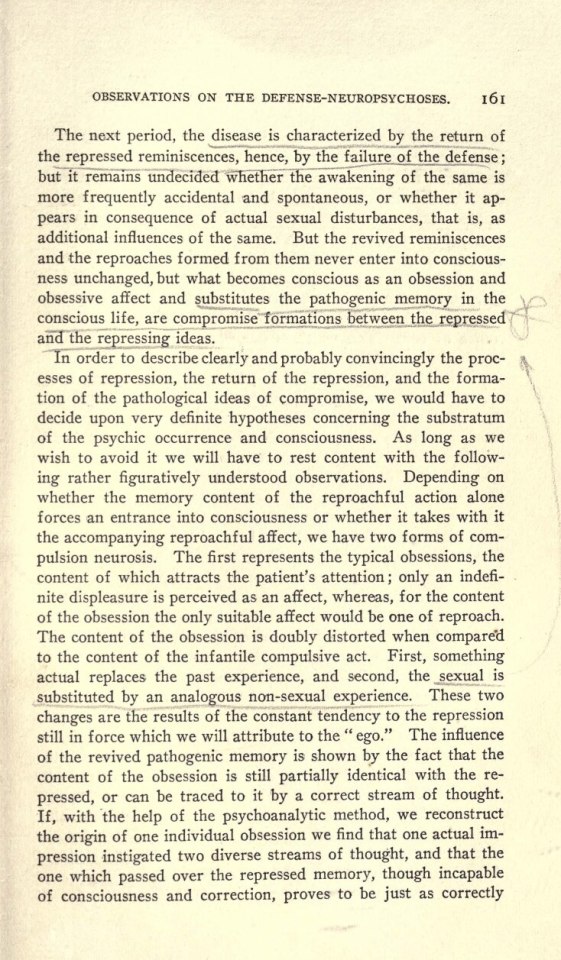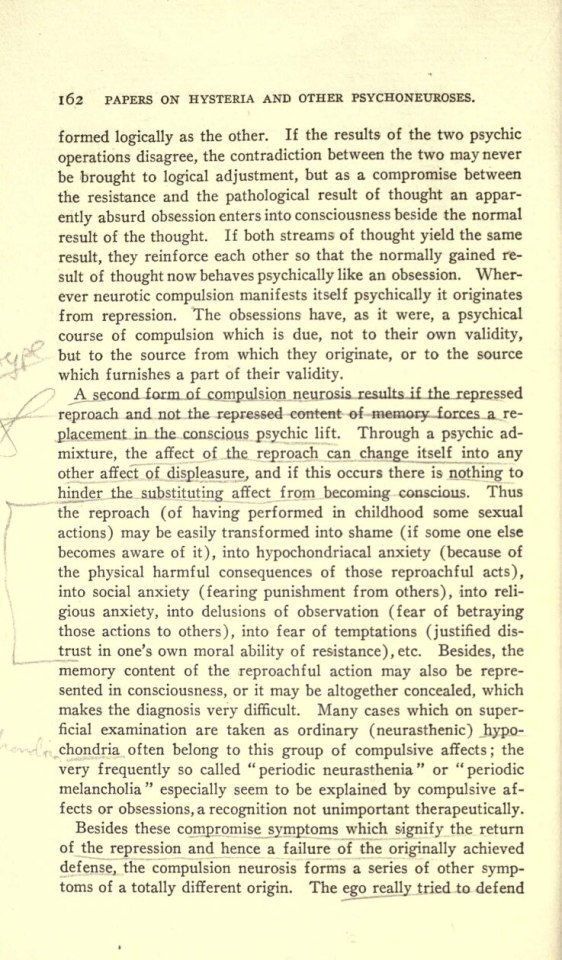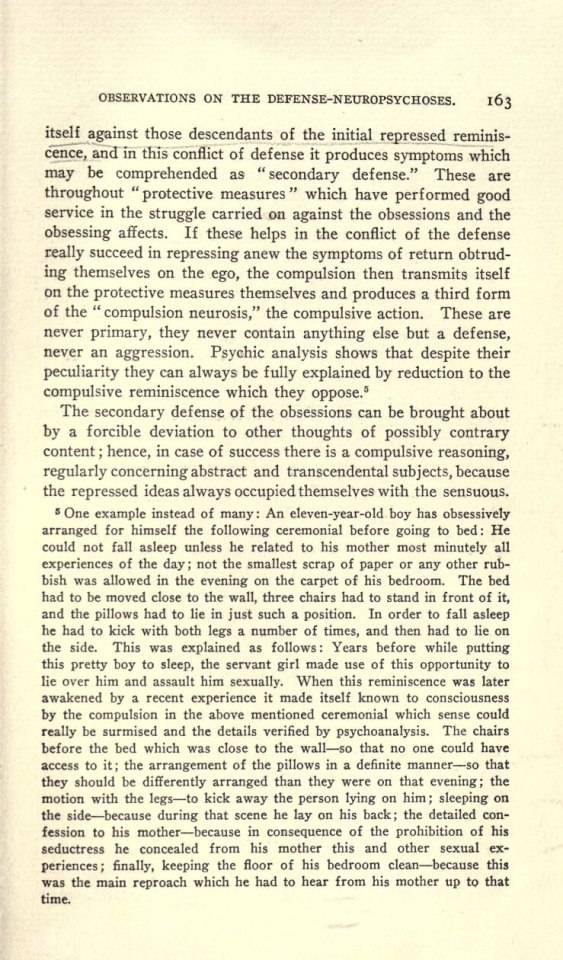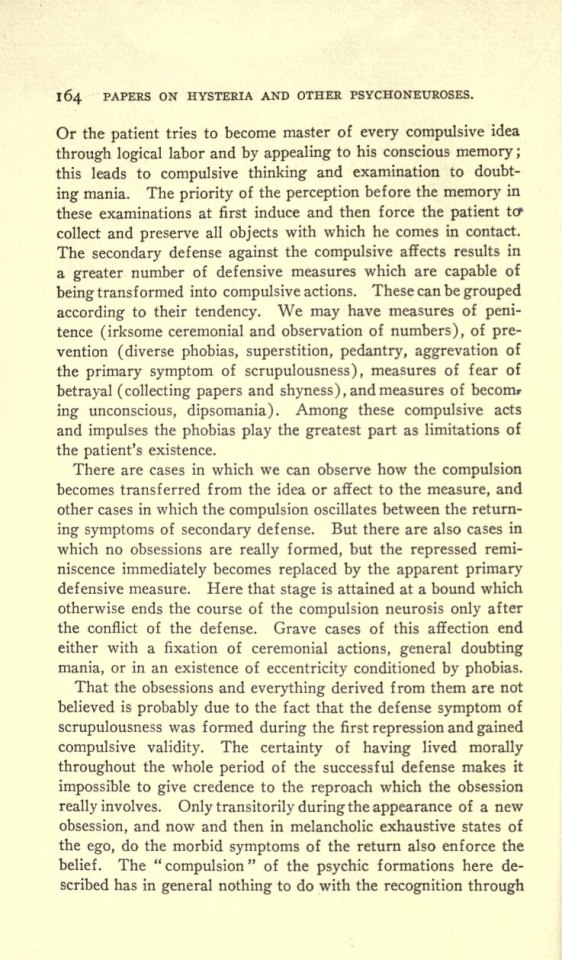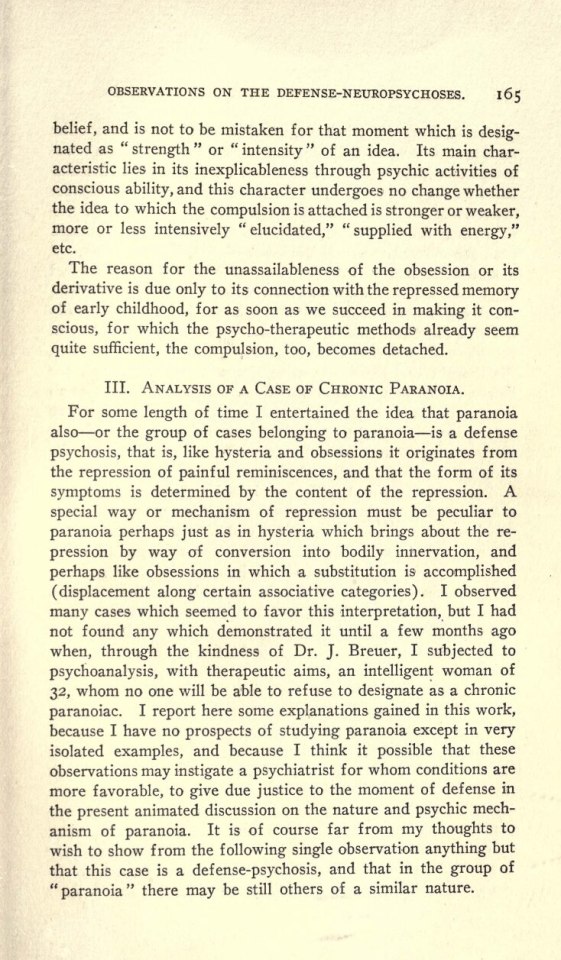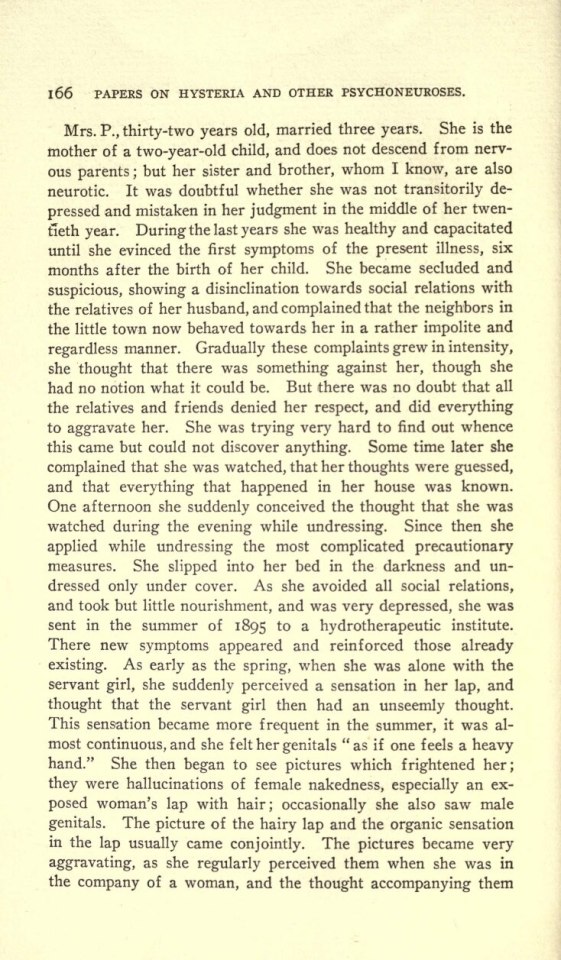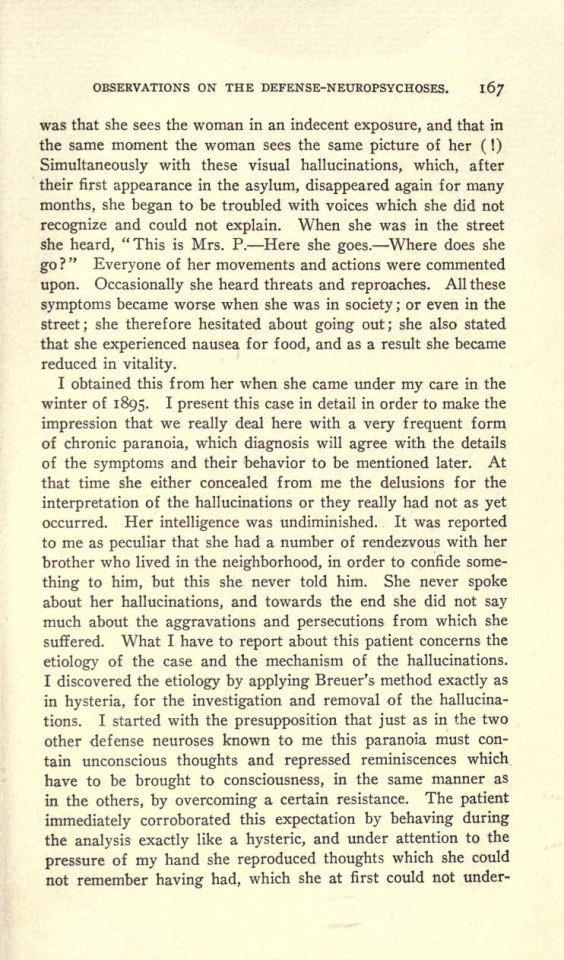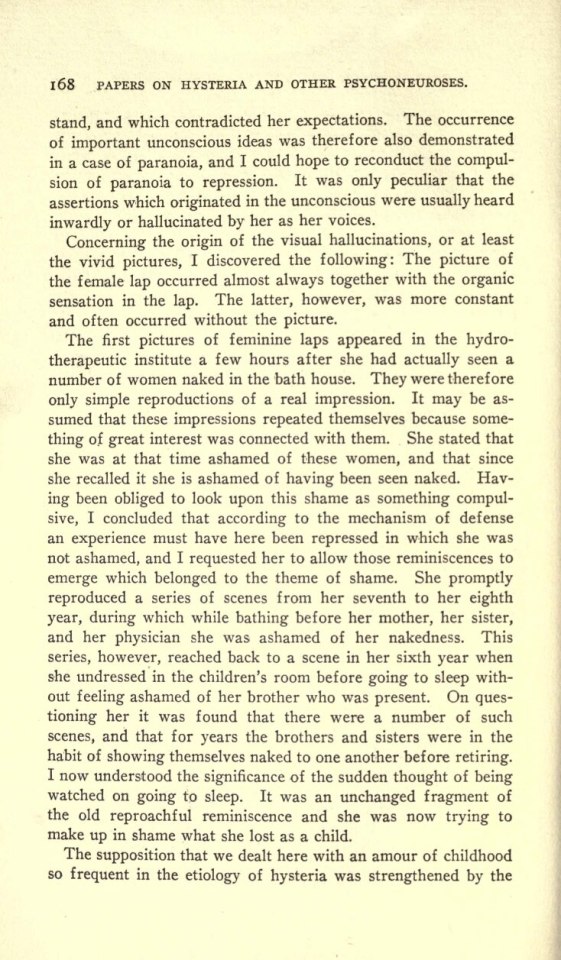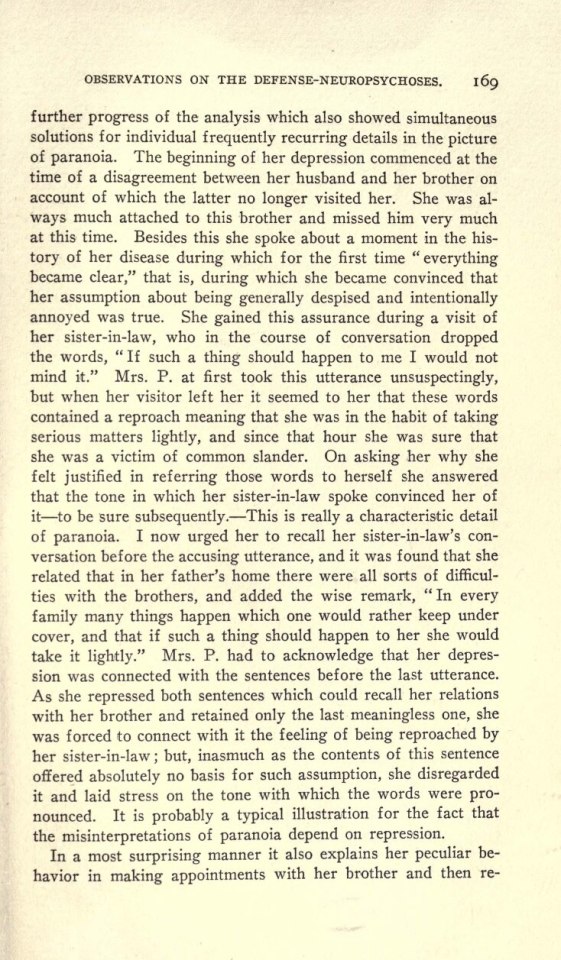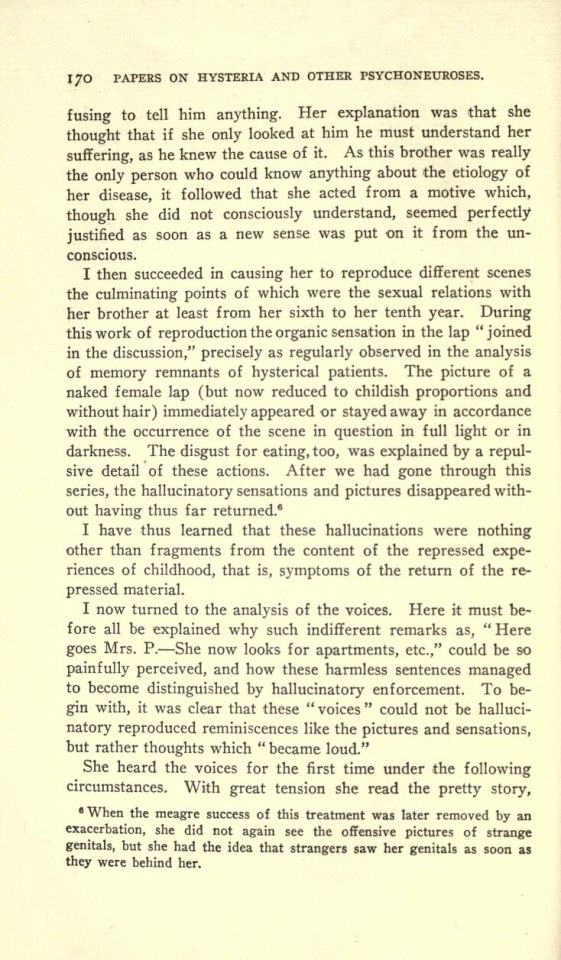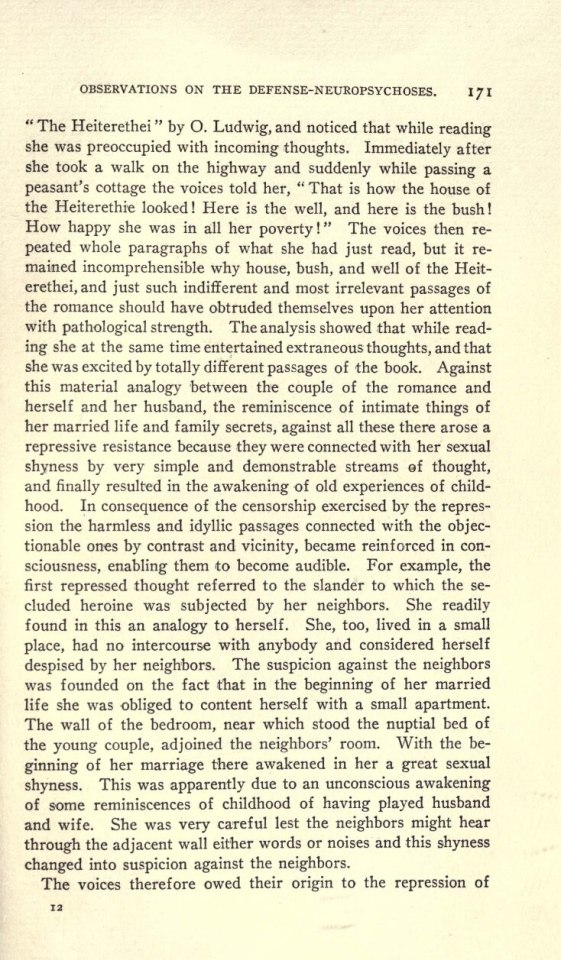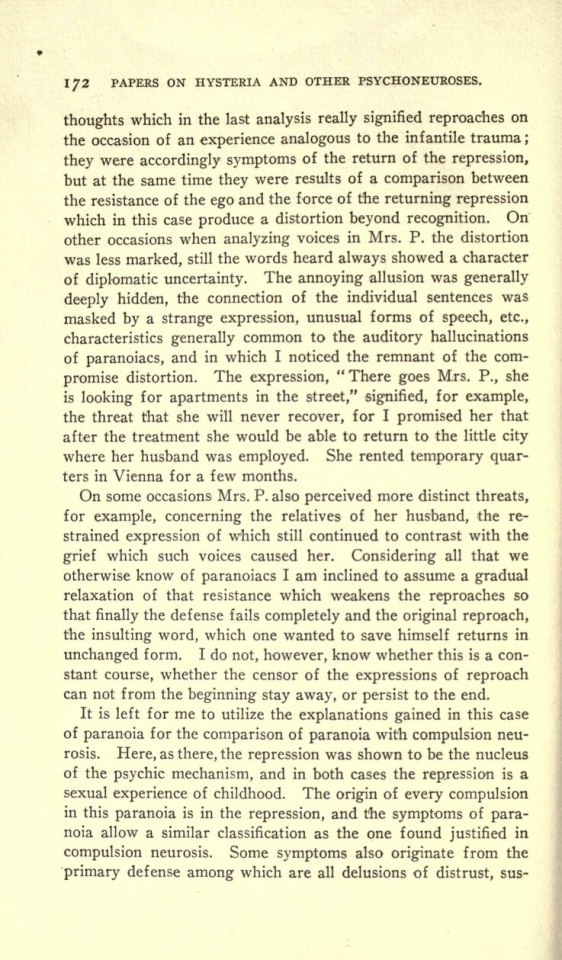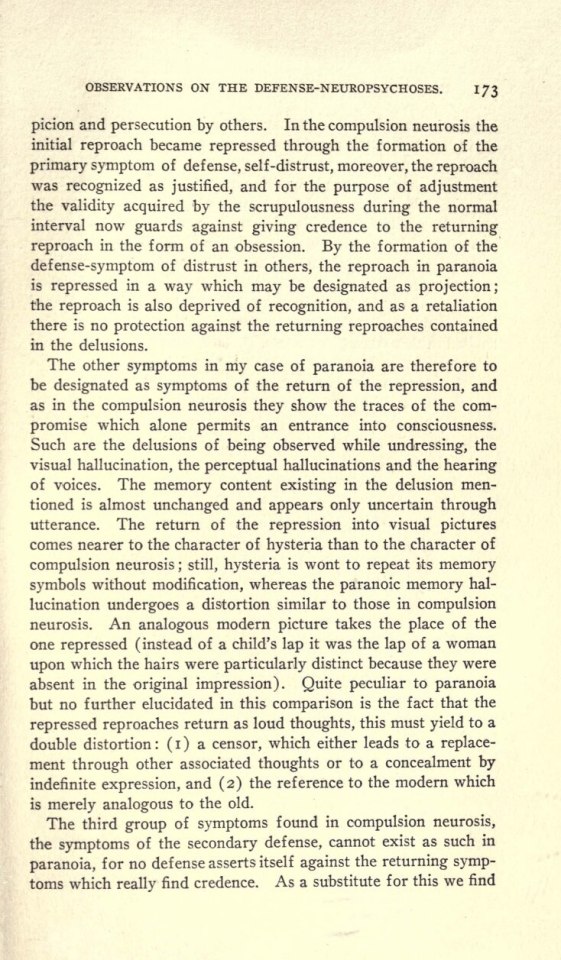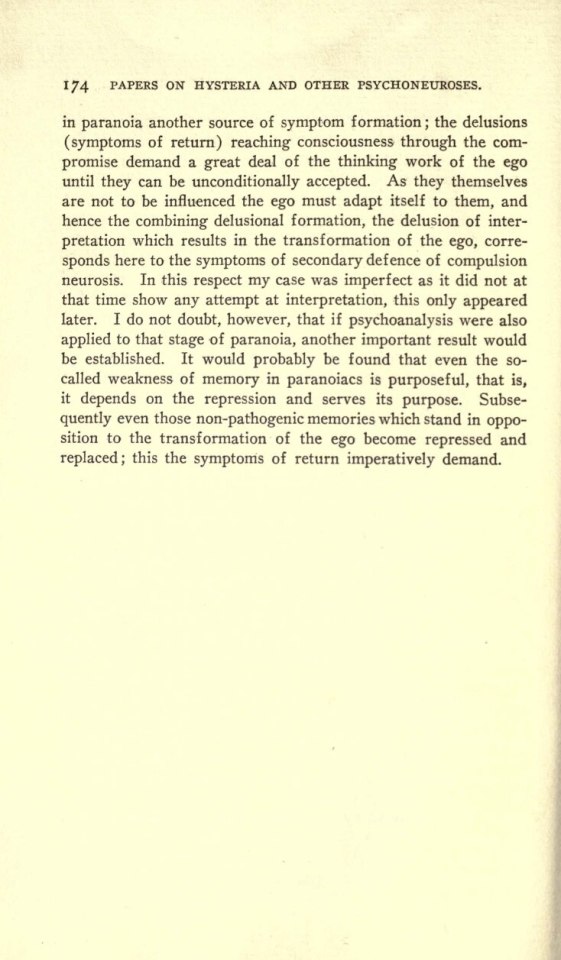S.
CHAPTER VII.
FurtHER OBSERVATIONS ON THE DEFENSE-NEUROPSYCHOSES.Under the caption of “ Defense-Neuropsychoses” I have com-
prised hysteria, obsessions, as well as certain cases of acute hal-
lucinatory confusion? All these affections evince one common
aspect in the fact that their symptoms originated through the
psychic mechanism of (unconscious) defense, that is, through the
attempt to repress an unbearable idea which appeared in painful
contrast to the ego of the patient. I was also able to explain
and exemplify by cases reported in the preceding chapters in
what sense this psychic process of “defense” or “repression”
is to be understood. I have also discussed the laborious but per-
fectly reliable method of psychoanalysis of which I make use
in my examinations, and which at the same time serves as a
therapy.My experiences during the last two years have strengthened
my predilection for making the defense the essential point in the
psychic mechanism of the mentioned neuroses, and on the other
hand have permitted me to give a clinical foundation to the
psychological theory. To my surprise I have discovered some
simple but sharply circumscribed solutions for the problem of
the neuroses which I shall provisionally briefly report in the fol-
lowing pages. It would be inconsistent with this manner of re-
porting to add to the assertions the required proofs, but I hope to
be able to fulfill this obligation in a comprehensive discussion.I. Tue “Speciric” Ertorocy or Hysteria.
That the symptoms of hysteria become comprehensible only
through a reduction to “traumatically ” effective experiences, and
that these psychic traumas refer to the sexual life has already
been asserted by Breuer and me in former publications. What
I have to add today as a uniform result of thirteen analyzed cases
of hysteria concerns, on the one hand, the nature of these sexual
traumas, and on the other, the period of life in which they oc-1 Neurologisches Centralblatt, 1896, Nr. 10.
IL 155
S.
156 PAPERS ON HYSTERIA AND OTHER PSYCHONEUROSES.
curred. An experience occurring at any period of life, touching
in any way the sexual life,and then becoming pathogenic through
the liberation and suppression of a painful affect is not sufficient
for a causation of hysteria. It must, on the contrary, belong
to the sexual traumas of early childhood (the period of life
before puberty), and its content must consist in a real irritation
of the genitals (coitus-like processes).This specific determination of hysteria—sexual passivity in
pre-sexual periods—I have found fulfilled in all analyzed cases
of hysteria (among which were two men). To what extent the
determination of the accidental etiological moment diminishes the
requirement of the hereditary predisposition needs only be inti-
mated. We can, moreover, understand the disproportionately
greater frequency of hysteria in the female sex, as even in child-
hood this sex is more subject to sexual assaults.The objection most frequently advanced against this result
may be to the purport, that sexual assaults on little children occur
too frequently to give an etiological value to its verification, or
that such experiences much remain ineffectual just because they
concern a sexually undeveloped being; and that one must more-
over be careful not to obtrude upon the patient through the ex-
amination such alleged reminiscences or believe in the romances
which they themselves fabricate. To the latter objections I hold
out the request that no one should really judge with great cer-
tainty this obscure realm unless he has made use of the only
method which can clear it up (the method of psychoanalysis for_ bringing to consciousness the hitherto unconscious?). The es-
sential point in the first doubts is settled by the observation that
it really is not the experiences themselves that act traumatically,
but their revival as reminiscences after the individual has entered
into sexual maturity.My thirteen cases of hysteria were throughout of the graver
kind, they were all of long duration, and some had undergone a
lengthy and unsuccessful asylum treatment. Every one of the
infantile traumas which the analysis revealed for their severe
cases had to be-designated as marked sexual injuries; some of21 myself surmise that the so frequently fabricated assaults of hyster-
ical persons are obsessional confabulations emanating from the memory
traces of infantile traumas.S.
OBSERVATIONS ON THE DEFENSE-NEUROPSYCHOSES, 157
them were indeed abominable. Among the persons who were
guilty of such serious abuse we have in the first place nurses,
governesses, and other servants to whom children are left much
too carelessly, then in regrettable frequency come the teachers;
but in seven of the thirteen cases we dealt with innocent childish
offenders, mostly brothers who for years entertained sexual re-
lations with their younger sisters. The course of events always
resembled some of the cases which could with certainty be
tracked, namely, that the boy had been abused by a person of the
feminine sex, thus awakening in him prematurely the libido, and
that after a few years he repeated in sexual aggression on his
sister the same procedures to. which he himself was subjected.I must exclude active masturbation from the list of sexual in-
juries of early childhood as being pathogenic for hysteria. That
it is so very frequently found associated with hysteria is due to
the fact that masturbation in itself is more frequently the result
of abuse or seduction than one supposes. It not seldom happens
that both members of a childish pair later in life become afflicted
by defense neuroses, the brother by obsessions and the sister by
hysteria, which naturally gives the appearance of a familial neu-
rotic predisposition. This pseudo-heredity is now and then
solved in a surprising manner. I have had under observation
a brother, sister, and a somewhat older cousin. The analysis
which I have undertaken with the brother showed me that he
suffered from reproaches for being the cause of his sister’s
malady; he himself was corrupted by his cousin, concerning
whom it was known in the family that he fell a victim to his
nurse.I can not definitely state up to what age sexual damage occurs
in the etiology of hysteria, but I doubt whether sexual passivity
can cause repression after the eighth and tenth year unless quali-
fied for it by previous experiences. The lower limit reaches as
far as memory in general, that is, to the delicate age of one and
one half or two years! (two cases). In a number of my cases
the sexual trauma (or the number of traumas) occurred during
the third and fourth year of life. I myself would not lend cre-
dence to this peculiar discovery if it were not for the fact that
the later development of the neurosis furnished it with full trust-
worthiness. In every case there are a number of morbid symp-S.
158 PAPERS ON HYSTERIA AND OTHER PSYCHONEUROSES.
toms, habits and phobias which are only explainable by return-
ing to those youthful experiences, and the logical structure of
the neurotic manifestation makes it impossible to reject the faith-
fully retained memories of childhood. Except through psycho-
analysis it is of no avail to ask a hysterical patient about these
infantile traumas; their remains can only be found in the morbid
symptoms and not in conscious memory.All the experiences and excitements which prepare the way for,
or occasion the outburst of, hysteria in the period of life after
puberty evidently act through the fact that they awaken the
memory remnants of those infantile traumas which do not become
conscious but lead to the liberation of affect and repression. It
is quite in harmony with this role of the later traumas not to be
subject to the strict limitation of the infantile traumas, but that
both in intensity and quality they can vary from an actual sexual
assault to a mere approximation of the sexual, such as perceiving
the sexual acts of others, or receiving information concerning
sexual processes.*In my first communication on the defense neuropsychoses I
failed to explain how the exertion of a hitherto healthy indi-
vidual to forget such traumatic happenings would result in the
real intentional repression, and thus open the door for the defense
neurosis. It can not depend on the nature of the experience, as
other persons remain unaffected despite the same motives. Hys-
teria can not therefore be fully explained by the effect of the
trauma, and we are forced to admit that the capacity for hysteria
already existed before the trauma.This indefinite hysterical predisposition can now wholly or par-
tially be substituted by the posthumous effect of the infantile
sexual trauma. The “repression” of the memory of a painful
sexual experience of maturer years can take place only in per-*In an article on the anxiety neurosis (Neurologisches Centralblatt,
1895, Nr. 2) I stated that “an anxiety neurosis which can almost typically
be combined with hysteria can be evoked in maturing girls at the first
encounter with the sexual problem.” I know today that the occasion in
which such virginal anxiety breaks out does not really correspond to the
first encounter with sexuality, but that in such persons there was inchildhood a precedent experience of sexual passivity which Memory was
awakened at the “first encounter.”S.
OBSERVATIONS ON THE DEFENSE-NEUROPSYCHOSES. 159
sons in whom this experience can bring into activity the memory
remnants of an infantile trauma.*The prerequisite of obsessions is also a sexual infantile expe-
rience, but of a different nature than that of hysteria. The
etiology of both defense neuropsychoses now shows the follow-
ing relation to the etiology of both simple neuroses, neurasthenia
and anxiety neurosis. As I have shown above, both the latter
neuroses are the direct results of the sexual noxas alone, while
both defense neuroses are the direct results of sexual noxas
which acted before the appearance of sexual maturity, that is,
they are the results of the psychic memory remnants of these
noxas. The actual causes producing neurasthenia and anxiety
neurosis simultaneously play the réle of inciting causes of the
defense neuroses, and on the other hand, the specific causes of
the defense neuroses, the infantile traumas, may simultaneously
prepare the soil for the later developing neurasthenias. Finally
it not seldom happens that the existence of a neurasthenia or
anxiety neurosis is only preserved by continued recollection of
an infantile trauma rather than by actual sexual injuries.+A psychological theory of the repression ought also to inform us why
only ideas of a sexual content can be repressed. It may be formulated
as follows: It is known that ideas of a sexual content produce exciting
processes in the genitals resembling the actual sexual experience. It may
be assumed that this somatic excitement becomes transformed into psychic.
As a rule the activity referred to is much stronger at the time of the
occurrence than at the recollection of the same. But if the sexual ex-
perience takes place during the time of sexual immaturity and the recol-
lection of the same is awakened during or after maturity the recollection
then acts disproportionately more exciting than the previous experience,
for puberty has in the mean time incomparably increased the reactive
capacity of the sexual apparatus. But such an inverse proportion seems
to contain the psychological determination of repression. Through the
retardation of the pubescent maturity in comparison with the psychic
function, the sexual life offers the only existing possibility for that in-
version of the relative efficacy. The infantile traumas subsequently act
like fresh experiences, but they are then unconscious. Deeper psycho-
logical discussions I will have to postpone for another time. I moreover
call attention to the fact that the here considered time of “sexual ma-
turity” does not coincide with puberty, but occurs before the same (eight
to ten years).S.
160 PAPERS ON HYSTERIA AND OTHER PSYCHONEUROSES.
II. Tue Essence AND MECHANISM OF CoMPULSION NEUROSIS.
Sexual riences of early childhood have the same signifi-
cance in the etiology of the compulsion. neurosis as in hysteria,
still we no longer deal here with sexual passivity but with pleas-
urably accomplished aggressions, and with pleasurably expe-~
rienced participation in sexual acts, that is, we deal here with
sexual activity. It is due to this difference in the etiological
relations that the masculine sex seems to be preferred in the
compulsion neurosis.In all my cases of compulsion neurosis I have found besides a
sub-soil of hysterical symptoms which could be traced to a pleas-
urable action of sexual passivity from a precedent scene. I pre-
sume that this coincidence is a lawful one and that_premature
sexual aggression always presupposes an experience of seduction.
But I am unable to present as yet a complete description of the
etiology of the compulsion neurosis. I only believe that the final
determination as to whether a hysteria or compulsion neurosis
should originate on the basis of infantile traumas depends on the
temporal relation of the development of the libido.The essence of the compulsion neurosis may be expressed in
the following simple formula: Obsessions are always ioe)formed reproaches returning from the repression which always.
refer to a pleasurably accomplished sexual action of childhood.” —
In order to elucidate this sentence it will be necessary to describe
the typical course of compulsion neurosis.In a first period—period of childish immorality—the events
containing the seeds of the later neurosis take place. In the
earliest childhood there appear at first the experiences of sexual
seduction which later makes the repression possibly, and this is
followed by the actions of sexual aggressions against the other
sex which later manifest themselves as actions of reproach.This period is brought to an end by the appearance of the—
often self ripened—sexual “maturity.” A reproach then attaches
itself to the memory of that pleasurable action, and the connec-
tion with the initial experience of passivity makes it possible—
often only after conscious and recollected effort—to repress it and - -
replace it by a primary symptom of defense. The third period,
that of apparent healthiness but really of successful defense, be-
gins with the symptoms of scrupulousnéss; stiame and diffidence.S.
OBSERVATIONS ON THE DEFENSE-NEUROPSYCHOSES. 161
The next period, the disease is characterized by the return of
the repressed reminiscences, hence, by the failure of the defense ;
but it reitiains undecided whether the awakening of the same is
more frequently accidental and spontaneous, or whether it ap-
pears in consequence of actual sexual disturbances, that is, as
additional influences of the same. But the revived reminiscences
and the reproaches formed from them never enter into conscious-
ness unchanged, but what becomes conscious as an obsession and
obsessive affect and substitutes the pathogenic memory in the
conscious life, are compromi e for -
and the repressing ideas.“In order to describe clearly and probably convincingly the proc-
esses of repression, the return of the repression, and the forma-
tion of the pathological ideas of compromise, we would have to
decide upon very definite hypotheses concerning the substratum
of the psychic occurrence and consciousness. As long as we
wish to avoid it we will have to rest content with the follow-
ing rather figuratively understood observations. Depending on
whether the memory content of the reproachful action alone
forces an entrance into consciousness or whether it takes with it
the accompanying reproachful affect, we have two forms of com-
pulsion neurosis. The first represents the typical obsessions, the
content of which attracts the patient’s attention; only an indefi-
nite displeasure is perceived as an affect, whereas, for the content
of the obsession the only suitable affect would be one of reproach.
The content of the obsession is doubly distorted when compared
to the content of the infantile compulsive act. First, something
actual replaces the past experience, and second, the sexual is
substituted by an analogous non-sexual experience. These two
changes are the results of the constant tendency to the repression
still in force which we will attribute to the “ego.” The influence
of the revived pathogenic memory is shown by the fact that the
content of the obsession is still partially identical with the re-
pressed, or can be traced to it by a correct stream of thought.
If, with the help of the psychoanalytic method, we reconstruct
the origin of one individual obsession we find that one actual im-
pression instigated two diverse streams of thought, and that the
one which passed over the repressed memory, though incapable
of consciousness and correction, proves to be just as correctlyS.
162 PAPERS ON HYSTERIA AND OTHER PSYCHONEUROSES.
formed logically as the other. If the results of the two psychic
operations disagree, the contradiction between the two may never
be brought to logical adjustment, but as a compromise between
the resistance and the pathological result of thought an appar-
ently absurd obsession enters into consciousness beside the normal
result of the thought. If both streams of thought yield the same
result, they reinforce each other so that the normally gained re-
sult of thought now behaves psychically like an obsession. Wher-
ever neurotic compulsion manifests itself psychically it originates
from repression. The obsessions have, as it were, a psychical
course of compulsion which is due, not to their own validity,
but to the source from which they originate, or to the source
which furnishes a part of their validity._A second form of compulsion neurosis results if the repressed
reproach and not the repressed content of -memory.forces a re-
Placement in the conscious psychic lift. Through a psychic ad-
other affect of displeasure, and if this occurs there is nothing to
hinder the substituting affect from becoming conscious. Thus
the reproach (of having performed in childhood some sexual
actions) may be easily transformed into shame (if some one else
becomes aware of it), into hypochondriacal anxiety (because of
the physical harmful consequences of those reproachful acts),
into social anxiety (fearing punishment from others), into reli-
gious anxiety, into delusions of observation (fear of betraying
those actions to others), into fear of temptations (justified dis-trust in one’s own moral ability of resistance),etc. Besides, the
memory content of the reproachful action may also be repre-
sented in consciousness, or it may be altogether concealed, which
makes the diagnosis very difficult. Many cases which on super-
ficial examination are taken as ordinary (neurasthenic) hypo-. chondria often belong to this group of compulsive affects; the
very frequently so called “periodic neurasthenia” or “ periodic
melancholia” especially seem to be explained by compulsive af-
fects or obsessions,a recognition not unimportant therapeutically.Besides these compromise symptoms which signify the return
of the repression and hence a failure of the originally achieved
defense, the compulsion neurosis forms a series of other symp-
toms of a totally different origin. The ego really tried to defendS.
OBSERVATIONS ON THE DEFENSE-NEUROPSYCHOSES. 163
itself_ against those descendants of the initial repressed reminis-
cence, and in this conflict of defense it produces symptoms which
may ‘be comprehended as “secondary defense.” These are
throughout “ protective measures” which have performed good
service in the struggle carried on against the obsessions and the
obsessing affects. If these helps in the conflict of the defense
really succeed in repressing anew the symptoms of return obtrud-
ing themselves on the ego, the compulsion then transmits itself
on the protective measures themselves and produces a third form
of the “compulsion neurosis,” the compulsive action. These are
never primary, they never contain anything else but a defense,
never an aggression. Psychic analysis shows that despite their
peculiarity they can always be fully explained by reduction to the
compulsive reminiscence which they oppose.®The secondary defense of the obsessions can be brought about
by a forcible deviation to other thoughts of possibly contrary
content ; hence, in case of success there is a compulsive reasoning,
regularly concerning abstract and transcendental subjects, because
the repressed ideas always occupied themselves with the sensuous.5 One example instead of many: An eleven-year-old boy has obsessively
arranged for himself the following ceremonial before going to bed: He
could not fall asleep unless he related to his mother most minutely all
experiences of the day; not the smallest scrap of paper or any other rub-
bish was allowed in the evening on the carpet of his bedroom. The bed
had to be moved close to the wall, three chairs had to stand in front of it,
and the pillows had to lie in just such a position. In order to fall asleep
he had to kick with both legs a number of times, and then had to lie on
the side. This was explained as follows: Years before while putting
this pretty boy to sleep, the servant girl made use of this opportunity to
lie over him and assault him sexually. When this reminiscence was later
awakened by a recent experience it made itself known to consciousness
by the compulsion in the above mentioned ceremonial which sense could
really be surmised and the details verified by psychoanalysis. The chairs
before the bed which was close to the wall—so that no one could have
access to it; the arrangement of the pillows in a definite manner—so that
they should be differently arranged than they were on that evening; the
motion with the legs—to kick away the person lying on him; sleeping on
the side—because during that scene he lay on his back; the detailed con-
fession to his mother—because in consequence of the prohibition of his
seductress he concealed from his mother this and other sexual ex-
Periences; finally, keeping the floor of his bedroom clean—because this
was the main reproach which he had to hear from his mother up to that
time.S.
164 PAPERS ON HYSTERIA AND OTHER PSYCHONEUROSES.
Or the patient tries to become master of every compulsive idea
through logical labor and by appealing to his conscious memory ;
this leads to compulsive thinking and examination to doubt-
ing mania. The priority of the perception before the memory in
these examinations at first induce and then force the patient to
collect and preserve all objects with which he comes in contact.
The secondary defense against the compulsive affects results in
a greater number of defensive measures which are capable of
being transformed into compulsive actions. These can be grouped
according to their tendency. We may have measures of peni-
tence (irksome ceremonial and observation of numbers), of pre-
vention (diverse phobias, superstition, pedantry, aggrevation of
the primary symptom of scrupulousness), measures of fear of
betrayal (collecting papers and shyness), and measures of becomr
ing unconscious, dipsomania). Among these compulsive acts
and impulses the phobias play the greatest part as limitations of
the patient’s existence,There are cases in which we can observe how the compulsion
becomes transferred from the idea or affect to the measure, and
other cases in which the compulsion oscillates between the return-
ing symptoms of secondary defense. But there are also cases in
which no obsessions are really formed, but the repressed remi-
niscence immediately becomes replaced by the apparent primary
defensive measure. Here that stage is attained at a bound which
otherwise ends the course of the compulsion neurosis only after
the conflict of the defense. Grave cases of this affection end
either with a fixation of ceremonial actions, general doubting
mania, or in an existence of eccentricity conditioned by phobias.That the obsessions and everything derived from them are not
believed is probably due to the fact that the defense symptom of
scrupulousness was formed during the first repression and gained
compulsive validity. The certainty of having lived morally
throughout the whole period of the successful defense makes it
impossible to give credence to the reproach which the obsession
really involves. Only transitorily during the appearance of a new
obsession, and now and then in melancholic exhaustive states of
the ego, do the morbid symptoms of the return also enforce the
belief. The “compulsion” of the psychic formations here de-
scribed has in general nothing to do with the recognition throughS.
OBSERVATIONS ON THE DEFENSE-NEUROPSYCHOSES, 165
belief, and is not to be mistaken for that moment which is desig-
nated as “strength” or “intensity” of an idea. Its main char-
acteristic lies in its inexplicableness through psychic activities of
conscious ability, and this character undergoes no change whether
the idea to which the compulsion is attached is stronger or weaker,
more or less intensively “elucidated,” “supplied with energy,”
etc.The reason for the unassailableness of the obsession or its
derivative is due only to its connection with the repressed memory
of early childhood, for as soon as we succeed in making it con-
scious, for which the psycho-therapeutic methods already seem
quite sufficient, the compulsion, too, becomes detached.TI. Anatysts or a Case or CHRONIC PARANOIA.
For some length of time I entertained the idea that paranoia
also—or the group of cases belonging to paranoia—is a defense
psychosis, that is, like hysteria and obsessions it originates from
the repression of painful reminiscences, and that the form of its
symptoms is determined by the content of the repression. A
special way or mechanism of repression must be peculiar to
paranoia perhaps just as in hysteria which brings about the re-
pression by way of conversion into bodily innervation, and
perhaps like obsessions in which a substitution is accomplished
(displacement along certain associative categories). I observed
many cases which seemed to favor this interpretation, but I had
not found any which demonstrated it until a few months ago
when, through the kindness of Dr. J. Breuer, I subjected to
psychoanalysis, with therapeutic aims, an intelligent woman of
32, whom no one will be able to refuse to designate as a chronic
paranoiac. I report here some explanations gained in this work,
because I have no prospects of studying paranoia except in very
isolated examples, and because I think it possible that these
observations may instigate a psychiatrist for whom conditions are
more favorable, to give due justice to the moment of defense in
the present animated discussion on the nature and psychic mech-
anism of paranoia. It is of course far from my thoughts to
wish to show from the following single observation anything but
that this case is a defense-psychosis, and that in the group of
“paranoia” there may be still others of a similar nature.S.
166 PAPERS ON HYSTERIA AND OTHER PSYCHONEUROSES.
Mrs. P., thirty-two years old, married three years. She is the
mother of a two-year-old child, and does not descend from nerv-
ous parents; but her sister and brother, whom I know, are also
neurotic. It was doubtful whether she was not transitorily de-
pressed and mistaken in her judgment in the middle of her twen-
fieth year. During the last years she was healthy and capacitated
until she evinced the first symptoms of the present illness, six
months after the birth of her child. She became secluded and
suspicious, showing a disinclination towards social relations with
the relatives of her husband, and complained that the neighbors in
the little town now behaved towards her in a rather impolite and
regardless manner. Gradually these complaints grew in intensity,
she thought that there was something against her, though she
had no notion what it could be. But there was no doubt that all
the relatives and friends denied her respect, and did everything
to aggravate her. She was trying very hard to find out whence
this came but could not discover anything. Some time later she
complained that she was watched, that her thoughts were guessed,
and that everything that happened in her house was known.
One afternoon she suddenly conceived the thought that she was
watched during the evening while undressing. Since then she
applied while undressing the most complicated precautionary
measures. She slipped into her bed in the darkness and un-
dressed only under cover. As she avoided all social relations,
and took but little nourishment, and was very depressed, she was
sent in the summer of 1895 to a hydrotherapeutic institute.
There new symptoms appeared and reinforced those already
existing. As early as the spring, when she was alone with the
servant girl, she suddenly perceived a sensation in her lap, and
thought that the servant girl then had an unseemly thought.
This sensation became more frequent in the summer, it was al-
most continuous, and she felt her genitals “as if one feels a heavy
hand.” She then began to see pictures which frightened her;
they were hallucinations of female nakedness, especially an ex-
posed woman’s lap with hair; occasionally she also saw male
genitals. The picture of the hairy lap and the organic sensation
in the lap usually came conjointly. The pictures became very
aggravating, as she regularly perceived them when she was in
the company of a woman, and the thought accompanying themS.
OBSERVATIONS ON THE DEFENSE-NEUROPSYCHOSES, 167
was that she sees the woman in an indecent exposure, and that in
the same moment the woman sees the same picture of her (!)
Simultaneously with these visual hallucinations, which, after
their first appearance in the asylum, disappeared again for many
months, she began to be troubled with voices which she did not
recognize and could not explain. When she was in the street
she heard, “This is Mrs. P—Here she goes——Where does she
go?” Everyone of her movements and actions were commented
upon. Occasionally she heard threats and reproaches. All these
symptoms became worse when she was in society ; or even in the
street; she therefore hesitated about going out; she also stated
that she experienced nausea for food, and as a result she became
reduced in vitality.I obtained this from her when she came under my care in the
winter of 1895. I present this case in detail in order to make the
impression that we really deal here with a very frequent form
of chronic paranoia, which diagnosis will agree with the details
of the symptoms and their behavior to be mentioned later. At
that time she either concealed from me the delusions for the
interpretation of the hallucinations or they really had not as yet
occurred. Her intelligence was undiminished. It was reported
to me as peculiar that she had a number of rendezvous with her
brother who lived in the neighborhood, in order to confide some-
thing to him, but this she never told him. She never spoke
about her hallucinations, and towards the end she did not say
much about the aggravations and persecutions from which she
suffered. What I have to report about this patient concerns the
etiology of the case and the mechanism of the hallucinations.
I discovered the etiology by applying Breuer’s method exactly as
in hysteria, for the investigation and removal of the hallucina-
tions. I started with the presupposition that just as in the two
other defense neuroses known to me this paranoia must con-
tain unconscious thoughts and repressed reminiscences which
have to be brought to consciousness, in the same manner as
in the others, by overcoming a certain resistance. The patient
immediately corroborated this expectation by behaving during
the analysis exactly like a hysteric, and under attention to the
pressure of my hand she reproduced thoughts which she could
not remember having had, which she at first could not under-S.
168 PAPERS ON HYSTERIA AND OTHER PSYCHONEUROSES,
stand, and which contradicted her expectations. The occurrence
of important unconscious ideas was therefore also demonstrated
in a case of paranoia, and I could hope to reconduct the compul-
sion of paranoia to repression. It was only peculiar that the
assertions which originated in the unconscious were usually heard
inwardly or hallucinated by her as her voices.Concerning the origin of the visual hallucinations, or at least
the vivid pictures, I discovered the following: The picture of
the female lap occurred almost always together with the organic
sensation in the lap. The latter, however, was more constant
and often occurred without the picture.The first pictures of feminine laps appeared in the hydro-
therapeutic institute a few hours after she had actually seen a
number of women naked in the bath house. They were therefore
only simple reproductions of a real impression. It may be as-
sumed that these impressions repeated themselves because some-
thing of great interest was connected with them. She stated that
she was at that time ashamed of these women, and that since
she recalled it she is ashamed of having been seen naked. Hav-
ing been obliged to look upon this shame as something compul-
sive, I concluded that according to the mechanism of defense
an experience must have here been repressed in which she was
not ashamed, and I requested her to allow those reminiscences to
emerge which belonged to the theme of shame. She promptly
reproduced a series of scenes from her seventh to her eighth
year, during which while bathing before her mother, her sister,
and her physician she was ashamed of her nakedness. This
series, however, reached back to a scene in her sixth year when
she undressed in the children’s room before going to sleep with-
out feeling ashamed of her brother who was present. On ques-
tioning her it was found that there were a number of such
scenes, and that for years the brothers and sisters were in the
habit of showing themselves naked to one another before retiring.
I now understood the significance of the sudden thought of being
watched on going to sleep. It was an unchanged fragment of
the old reproachful reminiscence and she was now trying to
make up in shame what she lost as a child.The supposition that we dealt here with an amour of childhood
so frequent in the etiology of hysteria was strengthened by theS.
OBSERVATIONS ON THE DEFENSE-NEUROPSYCHOSES, 169
further progress of the analysis which also showed simultaneous
solutions for individual frequently recurring details in the picture
of paranoia. The beginning of her depression commenced at the
time of a disagreement between her husband and her brother on
account of which the latter no longer visited her. She was al-
ways much attached to this brother and missed him very much
at this time. Besides this she spoke about a moment in the his-
tory of her disease during which for the first time “everything
became clear,” that is, during which she became convinced that
her assumption about being generally despised and intentionally
annoyed was true. She gained this assurance during a visit of
her sister-in-law, who in the course of conversation dropped
the words, “If such a thing should happen to me I would not
mind it.” Mrs. P. at first took this utterance unsuspectingly,
but when her visitor left her it seemed to her that these words
contained a reproach meaning that she was in the habit of taking
serious matters lightly, and since that hour she was sure that
she was a victim of common slander. On asking her why she
felt justified in referring those words to herself she answered
that the tone in which her sister-in-law spoke convinced her of
it—to be sure subsequently—This is really a characteristic detail
of paranoia. I now urged her to recall her sister-in-law’s con-
versation before the accusing utterance, and it was found that she
related that in her father’s home there were all sorts of difficul-
ties with the brothers, and added the wise remark, “In every
family many things happen which one would rather keep under
cover, and that if such a thing should happen to her she would
take it lightly.” Mrs. P. had to acknowledge that her depres-
sion was connected with the sentences before the last utterance.
As she repressed both sentences which could recall her relations
with her brother and retained only the last meaningless one, she
was forced to connect with it the feeling of being reproached by
her sister-in-law ; but, inasmuch as the contents of this sentence
offered absolutely no basis for such assumption, she disregarded
it and laid stress on the tone with which the words were pro-
nounced. It is probably a typical illustration for the fact that
the misinterpretations of paranoia depend on repression.In a most surprising manner it also explains her peculiar be-
havior in making appointments with her brother and then re-S.
170 PAPERS ON HYSTERIA AND OTHER PSYCHONEUROSES.
fusing to tell him anything. Her explanation was that she
thought that if she only looked at him he must understand her
suffering, as he knew the cause of it. As this brother was really
the only person who could know anything about the etiology of
her disease, it followed that she acted from a motive which,
though she did not consciously understand, seemed perfectly
justified as soon as a new sense was put on it from the un-
conscious.I then succeeded in causing her to reproduce different scenes
the culminating points of which were the sexual relations with
her brother at least from her sixth to her tenth year. During
this work of reproduction the organic sensation in the lap “ joined
in the discussion,” precisely as regularly observed in the analysis
of memory remnants of hysterical patients. The picture of a
naked female lap (but now reduced to childish proportions and
without hair) immediately appeared or stayed away in accordance
with the occurrence of the scene in question in full light or in
darkness. The disgust for eating, too, was explained by a repul-
sive detail of these actions. After we had gone through this
series, the hallucinatory sensations and pictures disappeared with-
out having thus far returned.®I have thus learned that these hallucinations were nothing
other than fragments from the content of the repressed expe-
riences of childhood, that is, symptoms of the return of the re-
pressed material.I now turned to the analysis of the voices. Here it must be-
fore all be explained why such indifferent remarks as, “Here
goes Mrs. P.—She now looks for apartments, etc.,” could be so
painfully perceived, and how these harmless sentences managed
to become distinguished by hallucinatory enforcement. To be-
gin with, it was clear that these “voices” could not be halluci-
natory reproduced reminiscences like the pictures and sensations,
but rather thoughts which “ became loud.”She heard the voices for the first time under the following
circumstances. With great tension she read the pretty story,© When the meagre success of this treatment was later removed by an
exacerbation, she did not again see the offensive pictures of strange
genitals, but she had the idea that strangers saw her genitals as soon as
they were behind her.S.
OBSERVATIONS ON THE DEFENSE-NEUROPSYCHOSES. 171
“The Heiterethei” by O. Ludwig, and noticed that while reading
she was preoccupied with incoming thoughts. Immediately after
she took a walk on the highway and suddenly while passing a
peasant’s cottage the voices told her, “That is how the house of
the Heiterethie looked! Here is the well, and here is the bush!
How happy she was in all her poverty!” The voices then re-
peated whole paragraphs of what she had just read, but it re-
mained incomprehensible why house, bush, and well of the Heit-
erethei, and just such indifferent and most irrelevant passages of
the romance should have obtruded themselves upon her attention
with pathological strength. The analysis showed that while read-
ing she at the same time entertained extraneous thoughts, and that
she was excited by totally different passages of the book. Against
this material analogy between the couple of the romance and
herself and her husband, the reminiscence of intimate things of
her married life and family secrets, against all these there arose a
repressive resistance because they were connected with her sexual
shyness by very simple and demonstrable streams of thought,
and finally resulted in the awakening of old experiences of child-
hood. In consequence of the censorship exercised by the repres-
sion the harmless and idyllic passages connected with the objec-
tionable ones by contrast and vicinity, became reinforced in con-
sciousness, enabling them to become audible. For example, the
first repressed thought referred to the slander to which the se-
cluded heroine was subjected by her neighbors. She readily
found in this an analogy to herself. She, too, lived in a small
place, had no intercourse with anybody and considered herself
despised by her neighbors. The suspicion against the neighbors
was founded on the fact that in the beginning of her married
life she was obliged to content herself with a small apartment.
The wall of the bedroom, near which stood the nuptial bed of
the young couple, adjoined the neighbors’ room. With the be-
ginning of her marriage there awakened in her a great sexual
shyness. This was apparently due to an unconscious awakening
of some reminiscences of childhood of having played husband
and wife. She was very careful lest the neighbors might hear
through the adjacent wall either words or noises and this shyness
changed into suspicion against the neighbors.The voices therefore owed their origin to the repression of
to
S.
172 PAPERS ON HYSTERIA AND OTHER PSYCHONEUROSES,
thoughts which in the last analysis really signified reproaches on
the occasion of an experience analogous to the infantile trauma;
they were accordingly symptoms of the return of the repression,
but at the same time they were results of a comparison between
the resistance of the ego and the force of the returning repression
which in this case produce a distortion beyond recognition. On’
other occasions when analyzing voices in Mrs. P. the distortion
was less marked, still the words heard always showed a character
of diplomatic uncertainty. The annoying allusion was generally
deeply hidden, the connection of the individual sentences was
masked by a strange expression, unusual forms of speech, etc.,
characteristics generally common to the auditory hallucinations
of paranoiacs, and in which I noticed the remnant of the com-
promise distortion. The expression, “There goes Mrs. P., she
is looking for apartments in the street,” signified, for example,
the threat that she will never recover, for I promised her that
after the treatment she would be able to return to the little city
where her husband was employed. She rented temporary quar-
ters in Vienna for a few months.On some occasions Mrs. P. also perceived more distinct threats,
for example, concerning the relatives of her husband, the re-
strained expression of which still continued to contrast with the
grief which such voices caused her. Considering all that we
otherwise know of paranoiacs I am inclined to assume a gradual
relaxation of that resistance which weakens the reproaches so
that finally the defense fails completely and the original reproach,
the insulting word, which one wanted to save himself returns in
unchanged form. I do not, however, know whether this is a con-
stant course, whether the censor of the expressions of reproach
can not from the beginning stay away, or persist to the end.It is left for me to utilize the explanations gained in this case
of paranoia for the comparison of paranoia with compulsion neu-
rosis. Here, as there, the repression was shown to be the nucleus
of the psychic mechanism, and in both cases the repression is a
sexual experience of childhood. The origin of every compulsion
in this paranoia is in the repression, and the symptoms of para-
noia allow a similar classification as the one found justified in
compulsion neurosis. Some symptoms also originate from the
primary defense among which are all delusions of distrust, sus-S.
OBSERVATIONS ON THE DEFENSE-NEUROPSYCHOSES, 173
picion and persecution by others. Inthe compulsion neurosis the
initial reproach became repressed through the formation of the
primary symptom of defense, self-distrust, moreover, the reproach
was recognized as justified, and for the purpose of adjustment
the validity acquired by the scrupulousness during the normal
interval now guards against giving credence to the returning
reproach in the form of an obsession. By the formation of the
defense-symptom of distrust in others, the reproach in paranoia
is repressed in a way which may be designated as projection;
the reproach is also deprived of recognition, and as a retaliation
there is no protection against the returning reproaches contained
in the delusions.The other symptoms in my case of paranoia are therefore to
be designated as symptoms of the return of the repression, and
as in the compulsion neurosis they show the traces of the com-
promise which alone permits an entrance into consciousness.
Such are the delusions of being observed while undressing, the
visual hallucination, the perceptual hallucinations and the hearing
of voices. The memory content existing in the delusion men-
tioned is almost unchanged and appears only uncertain through
utterance. The return of the repression into visual pictures
comes nearer to the character of hysteria than to the character of
compulsion neurosis; still, hysteria is wont to repeat its memory
symbols without modification, whereas the paranoic memory hal-
lucination undergoes a distortion similar to those in compulsion
neurosis. An analogous modern picture takes the place of the
one repressed (instead of a child’s lap it was the lap of a woman
upon which the hairs were particularly distinct because they were
absent in the original impression). Quite peculiar to paranoia
but no further elucidated in this comparison is the fact that the
repressed reproaches return as loud thoughts, this must yield to a
double distortion: (1) a censor, which either leads to a replace-
ment through other associated thoughts or to a concealment by
indefinite expression, and (2) the reference to the modern which
is merely analogous to the old.The third group of symptoms found in compulsion neurosis,
the symptoms of the secondary defense, cannot exist as such in
paranoia, for no defense asserts itself against the returning symp-
toms which really find credence. As a substitute for this we findS.
174 PAPERS ON HYSTERIA AND OTHER PSYCHONEUROSES.
in paranoia another source of symptom formation; the delusions
(symptoms of return) reaching consciousness through the com-
promise demand a great deal of the thinking work of the ego
until they can be unconditionally accepted. As they themselves
are not to be influenced the ego must adapt itself to them, and
hence the combining delusional formation, the delusion of inter-
pretation which results in the transformation of the ego, corre-
sponds here to the symptoms of secondary defence of compulsion
neurosis. In this respect my case was imperfect as it did not at
that time show any attempt at interpretation, this only appeared
later. I do not doubt, however, that if psychoanalysis were also
applied to that stage of paranoia, another important result would
be established. It would probably be found that even the so-
called weakness of memory in paranoiacs is purposeful, that is,
it depends on the repression and serves its purpose. Subse-
quently even those non-pathogenic memories which stand in oppo-
sition to the transformation of the ego become repressed and
replaced; this the symptoms of return imperatively demand.atl tae hte
freud-1920-hysteria-3
155
–174
